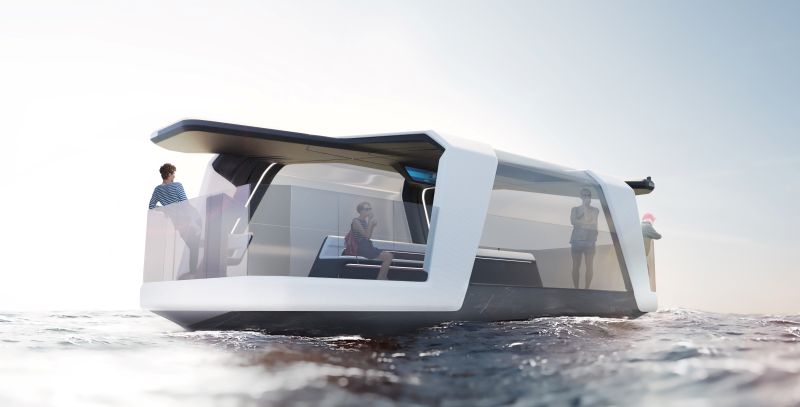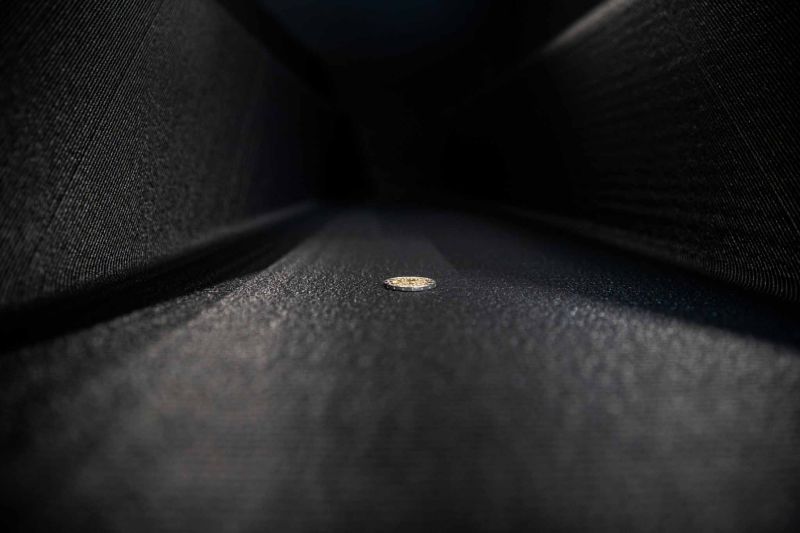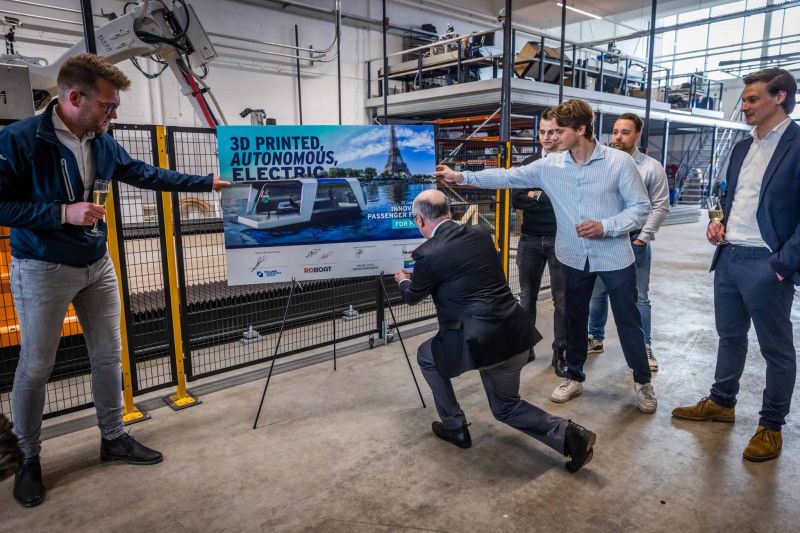3D printed, autonomous, and electric! That’s the promise from partners Roboat, Holland Shipyards Group, and Sequana Développement as they kicked off the production process for a state-of-the-art passenger ferry that will debut in Paris just in time for the 2024 Summer Olympics.
 Rendering of the 3D printed autonomous ferry for the 2024 Olympics. Image courtesy of Roboat.
Rendering of the 3D printed autonomous ferry for the 2024 Olympics. Image courtesy of Roboat.Last December, the three companies were designated as the winning consortium in a national call for autonomous decarbonated passenger boat projects initiated by the French inland waterway authority, the Voies Navigables de France (VNF). The goal of the Nation is not only to host the games but to set an example of environmental respect by betting on alternative and low-carbon mobility, mainly to transport passengers along the river. This is the result of their efforts.
Under the premise of building a Ferry in a couple of months, the three companies chose 3D printing to help them complete the boat as quickly as possible. That means no steel or aluminum welding but, instead, a gigantic 3D printer constructing the steel structure (or keel) along the base of a new passenger ferry concept. Friday, March 31, 2023, marked the day the teams held a “keel printing” ceremony at the Roboat facility in Amsterdam for the first time, and as a ceremonial tradition for good luck, a French coin was placed in the keel of the boat.
 A French coin was placed in the keel of the ferry that will be 3D printed and autonomous. Image courtesy of Roboat.
A French coin was placed in the keel of the ferry that will be 3D printed and autonomous. Image courtesy of Roboat.“The 3D print build method opens up a new exciting chapter in shipbuilding, ” says Leendert Hoogendoorn, director of Holland Shipyards Group, the Dutch shipbuilder behind several green ferry projects in Europe.
Packed with innovation, the new boat will be deployed in the summer of 2024 in a location still under wrap. Capable of transporting up to 35 people, the ship will operate on the river Seine, connecting the Athlete’s Village site with the island of L’Île-Saint-Denis during the Games. In just a few months, the ferry will be built, tested, and shipped to France, where visitors worldwide will glimpse what the trio calls “the future of waterborne mobility.”
 3D printing has begun for the autonomous ferry to debut in the 2024 Olympics. Image courtesy of Roboat.
3D printing has begun for the autonomous ferry to debut in the 2024 Olympics. Image courtesy of Roboat.Described by the consortium as the largest 3D printed boat made to date, the state-of-the-art ferry will measure nine meters long and almost four meters wide. To add to the list of features, it will also become one of the first autonomous ferries in operation with electric propulsion, will charge wirelessly, and be able to dock and moor automatically. Even more so, the companies chose recycled materials to 3D print the hull, in line with the Olympic committee’s environmental ambitions, including a goal to halve the emissions arising in relation to the Games while offsetting even more CO2 emissions than it will generate.
Since 2019, Paris has been pioneering innovations for low-carbon mobility and making alternative modes of transport attractive. By using autonomous electric ferries, the city will have a sustainable solution for reducing traffic congestion and emissions, as ferries help cities solve their growing mobility needs by using the waterways better.
“Autonomous ferries will create new connections over existing waterways in cities worldwide,” explains Ynse Deinema, CEO of Roboat. “We are extremely proud of this opportunity where top-level sport and shipbuilding meet and match in quality, passion and progressive approach!”
 Rendering of the 3D printed autonomous ferry for the 2024 Olympics. Image courtesy of Roboat.
Rendering of the 3D printed autonomous ferry for the 2024 Olympics. Image courtesy of Roboat.The result of five years of research, Roboat’s “smarter ships” began as small vessel prototypes at the Massachusetts Institute of Technology (MIT) in late 2015. Thanks to a joint research program between the university and the Amsterdam Institute for Advanced Metropolitan Solutions (AMS Institute), the first two futuristically designed self-driving Roboats capable of carrying five passengers were presented during a demo event in 2021, and they have been operating on the canals of Amsterdam for months. By the beginning of 2023, Roboat spun off as a startup to share the technology with the world.
 Inside the 3D printed autonomous ferry for the 2024 Olympics. Image courtesy of Roboat.
Inside the 3D printed autonomous ferry for the 2024 Olympics. Image courtesy of Roboat.Although the Roboat’s unveiling will be highly anticipated, it’s not the only autonomous 3D printed ferry in development. Earlier this year, Al Seer Marine, a maritime equipment manufacturer, and services provider based in Abu Dhabi unveiled HYDRA, considered among the world’s first 3D printed uncrewed surface vessel (USV) or drone boat. HYDRA was printed using a composite-based system made by Dutch original equipment manufacturer (OEM) CEAD, which lauds the machine as the world’s largest robotic-arm 3D printer.
3D printed boats can be more environmentally friendly than traditional boats. For example, a boat made out of plastic waste straight out of the 3D printer is what Dutch startup Tanaruz proposes for its 15 feet electric boat.
At the forefront of cutting-edge AM technology for the maritime industry is the University of Maine, which has 3D printed large-scale boats at its Advanced Structures and Composites Center in Orono, one of which is reportedly the largest vessel ever additively manufactured. Thanks to its extensive polymer 3D printing system, developed by Ingersoll Machine Tools, the extrusion-based printer is ideally built for defense and infrastructure applications, capable of printing objects as long as 100 feet, 22 feet wide, and 10 feet high.
Subscribe to Our Email Newsletter
Stay up-to-date on all the latest news from the 3D printing industry and receive information and offers from third party vendors.
You May Also Like
3D Printing Webinar and Event Roundup: April 14, 2024
We’re starting off the week’s 3D printing webinars and events at ASTM AMCOE’s 11th Snapshot Workshop and MACH Exhibition. Stratasys continues its advanced training courses, SME is holding a virtual...
Westinghouse Achieves Serial 3D Printing of Nuclear Power Part
According to the “Additive Manufacturing in the Energy Sector: Market Analysis & Forecast” report from Additive Manufacturing Research (AMR), the energy sector saw $2.6 billion worth of 3D printing activity...
New EOS M 290 1kW Enables Copper 3D Printing for New Space, Automotive, and More
EOS has released a new EOS M 290 1kW metal powder bed fusion (PBF) system, designed specifically with copper in mind. Initially developed by its custom machine building subsidiary, AMCM,...
What’s Next for Additive Manufacturing Materials?
As many additive manufacturing (AM) users and engineers know, material science is just as important as the industrial 3D printing technology itself. Both work in tandem to help manufacturers reach...































